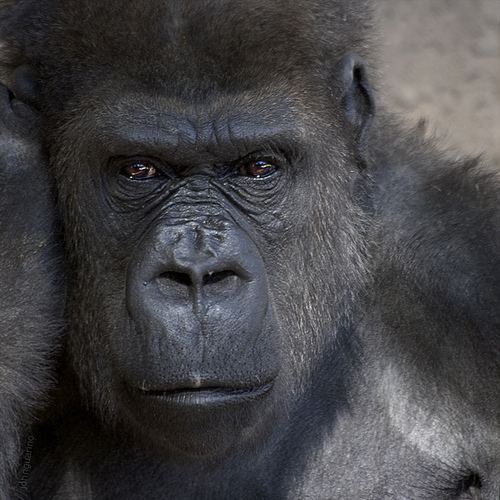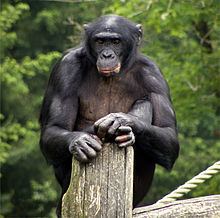Scientific name Homininae Rank Subfamily | Phylum Chordata | |
 | ||
Lower classifications | ||
Homininae is a subfamily of Hominidae.
Contents
- History of discoveries and classification
- Taxonomic classification
- Evolution of bipedalism
- Brain size evolution
- Evolution of family structure and sexuality
- References
It includes two tribes, with their extant as well as extinct species: the Hominini tribe (with the genus Homo including modern humans, and the genus Pan including chimpanzees and bonobos), and the Gorillini tribe (gorillas). It comprises all hominids that arose after orangutans (subfamily Ponginae) split from the line of great apes. The Homininae cladogram has three main branches, which lead to gorillas (through the tribe Gorillini), and to humans and chimpanzees via the tribe Hominini and subtribes Hominina and Panina (see the evolutionary tree below). There are two living species of Panina (chimpanzees and bonobos) and two living species of gorillas, but only one extant human species. Traces of hypothetical Homo species, including Homo floresiensis and Homo denisova, have been found with dates as recent as 12,000 years ago. Organisms in this class are described as hominine or hominines (not to be confused with the terms hominins or hominini).

History of discoveries and classification

Until 1980, the family (and term) Hominidae meant humans only; the non-human great apes were assigned to the family Pongidae. Later discoveries led to revised classifications, with the great apes then united with humans (now in subfamily Homininae) as members of family Hominidae Further discoveries indicated that gorillas and chimpanzees are more closely related to humans than they are to orangutans, leading to their (gorillas and chimpanzees) placement in subfamily Homininae as well.

The subfamily Homininae can be further subdivided into three branches: the tribe Gorillini (gorillas), and the tribe Hominini with subtribes Panina (chimpanzees) and Hominina (humans and their extinct relatives). The Late Miocene fossil Nakalipithecus nakayamai, described in 2007, is a basal member of this clade, as is, perhaps, its contemporary Ouranopithecus; that is, they are not assignable to any of the three extant branches. Their existence suggests that the Homininae tribes diverged not earlier than about 8 million years ago (see Human evolutionary genetics).

Today, chimpanzees and gorillas live in tropical forests with acid soils that rarely preserve fossils. Although no fossil gorillas have been reported, four chimpanzee teeth about 500,000 years old have been discovered in the East-African rift valley (Kapthurin Formation, Kenya), where many fossils from the human lineage (hominins) have been found. This shows that some chimpanzees lived close to Homo (H. erectus or H. rhodesiensis) at the time; the same is likely true for gorillas.
Taxonomic classification
Homininae

Evolution of bipedalism
Recent studies of Ardipithecus ramidus (4.4 million years old) and Orrorin tugenensis (6 million years old) suggest some degree of bipedalism. Australopithecus and early Paranthropus may have been bipedal. Very early hominins such as Ardipithecus ramidus may have possessed an arboreal type of bipedalism. and towards efficient walking and running in modern humans.
Brain size evolution
There has been a gradual increase in brain volume (brain size) as the ancestors of modern humans progressed along the timeline of human evolution, starting from about 600 cm3 in Homo habilis up to 1500 cm3 in Homo neanderthalensis. However, modern Homo sapiens have a brain volume slightly smaller (1250 cm3) than Neanderthals, women have a brain slightly smaller than men and the Flores hominids (Homo floresiensis), nicknamed hobbits, had a cranial capacity of about 380 cm3 (considered small for a chimpanzee), about a third of the Homo erectus average. It is proposed that they evolved from H. erectus as a case of insular dwarfism. In spite of their smaller brain, there is evidence that H. floresiensis used fire and made stone tools at least as sophisticated as those of their proposed ancestors H. erectus. In this case, it seems that for intelligence, the structure of the brain is more important than its size.
Evolution of family structure and sexuality
Sexuality is related to family structure and partly shapes it. The involvement of fathers in education is quite unique to humans, at least when compared to other Homininae. Concealed ovulation and menopause in women both also occur in a few other primates however, but are uncommon in other species. Testis and penis size seems to be related to family structure: monogamy or promiscuity, or harem, in humans, chimpanzees or gorillas, respectively. The levels of sexual dimorphism are generally seen as a marker of sexual selection. Studies have suggested that the earliest hominins were dimorphic and that this lessened over the course of the evolution of the genus Homo, correlating with humans becoming more monogamous, whereas gorillas, who live in harems, show a large degree of sexual dimorphism. Concealed (or "hidden") ovulation means that the phase of fertility is not detectable in women, whereas chimpanzees advertise ovulation via an obvious swelling of the genitals. Women can be partly aware of their ovulation along the menstrual phases, but men are essentially unable to detect ovulation in women. Most primates have semi-concealed ovulation, thus one can think that the common ancestor had semi-concealed ovulation, that was inherited by gorillas, and that later evolved in concealed ovulation in humans and advertised ovulation in chimpanzees. Menopause also occurs in rhesus monkeys, and possibly in chimpanzees, but does not in gorillas and is quite uncommon in other primates (and other mammal groups).
